Ijraset Journal For Research in Applied Science and Engineering Technology
- Home / Ijraset
- On This Page
- Abstract
- Introduction
- Conclusion
- References
- Copyright
Analysis of Heavy Metals in Water and Wastewater
Authors: Deeksha R, Deeksha Singh, Kashish Dokania, Madiha Mujawar
DOI Link: https://doi.org/10.22214/ijraset.2024.64077
Certificate: View Certificate
Abstract
The primary focus of the study is to assess the presence and concentration of heavy metals in the water and evaluate its suitability for drinking purposes. Given that a significant portion of the local population depends on groundwater for their daily needs, the study is critical in understanding the potential health risks associated with consuming contaminated water. The study begins with a comprehensive survey to gauge the extent of water usage among the local population and their perceptions of water quality. Results from the survey reveal that nearly half of the households in the region are not connected to a formal drinking water network, relying instead on wells and springs. While the majority of respondents perceive the water quality as good, the analytical findings suggest otherwise. Groundwater samples were collected from twelve wells and three springs across the region. These samples were subjected to rigorous analysis using inductively coupled plasma-atomic emission spectrometry (ICP-AES) to detect the concentration of various heavy metals, including aluminum, silver, iron, cadmium, arsenic, chromium, cobalt, zinc, lead, and copper. The results indicate that many of these metals are present in concentrations that exceed the World Health Organization\'s recommended limits for safe drinking water. Iron, in particular, was found at high levels in all sampled locations, raising significant concerns. The study also employs the Heavy Metal Pollution Index (HPI) to provide a more comprehensive assessment of water quality. The HPI values calculated for the sampled water sources reveal that a majority of the wells and all of the springs have levels of heavy metal contamination that render the water non-potable. This finding is particularly alarming given the region\'s dependence on water, especially during periods of drought when alternative water sources are scarce.
Introduction
I. INTRODUCTION
This paper focuses on the analysis of heavy metal contamination in water sources, with specific emphasis on the environmental and public health implications of these pollutants. The paper begins by establishing the context and significance of the study, explaining how heavy metal contamination is a critical environmental issue that affects water quality worldwide, particularly in regions with a history of industrial or mining activities. It proceeds to highlight the sources of heavy metals in the environment, including natural geological processes and human activities such as mining, industrial discharge, and agricultural runoff. It emphasizes the health risks associated with exposure to heavy metals, such as lead (Pb), cadmium (Cd), and mercury (Hg), which can cause serious health problems, including neurological damage and kidney failure, even at low concentrations. Furthermore, the paper outlines the methodology used in the study, indicating that a range of scientific techniques and instruments, such as Inductively Coupled Plasma-Atomic Emission Spectroscopy (ICP-AES), were employed to measure the concentrations of various heavy metals in water, sediments, and possibly biota. The importance of using such methods to ensure accuracy and reliability in detecting and quantifying pollutants will be emphasized. It also provides an overview of the study’s objectives, which could include assessing the current state of water quality, identifying potential sources of contamination, and evaluating the effectiveness of existing environmental regulations or management practices in mitigating these pollutants.
II. LITERATURE REVIEW
1) Analysis of heavy metals concentration in water and sediment in the Hara biosphere reserve, southern Iran by Mohsen Nowrouzi, Borhan Mansouri, Sahar Nabizadeh and Alireza Pourkhabbaz
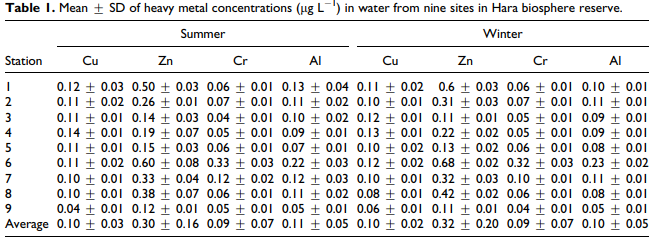
The paper under discussion, Analysis of heavy metals concentration in water and sediment in the Hara biosphere reserve, southern Iran, by Mohsen Nowrouzi et al focuses on concentration of Al, Cr, Cu, Zn in water and sediments in 9 locations, in summer and winter of 2010. The effectiveness of heavy metal concentrations in water was done in the order; Zn > Al > Cu > Cr while in sediments it was determined in the order; Cr > Zn > Cu > Al; Significant seasonality was recorded whereby, Cr, Cu, and Zn has season variation which was different during the summer and winter. It also analyzed the dependency of metal concentrations with the physicochemical characteristics like pH and the organic matter content in sediments. Thus, the obtained results pointed out significant correlation coefficients for Cu, Zn, and Cr in sediments in winter period. According to the findings, industrial outputs, wastewater, and agricultural drainage were considered to be the main sources of the chemical pollutants. The work established that it is the sediments not water which tend to contain relatively higher concentrations of heavy metals and hence constitute a menace within the aquatic environment. Hence, constant and continuous surveys and strict environmental pollution regulation should be implemented to prevent the effects that heavy metals have on the biosphere reserve. The results of this study aid the existing scant literature on heavy metal pollution in aquatic habitats in the southern part of Iran, which would be important for baseline data and reference when it comes to environmental planning and decisions in the region.
2) Determination of Some Selected Heavy Metals in Water, Oreochromis niloticus and Labeobarbus intermedius Samples From Abaya and Chamo Lakes By Dugasa Gerenfes, Endale Teju
The paper by Dugasa Gerenfes and Endale Teju namely “Determination of Some Selected Heavy Metals in Water, Oreochromis niloticus and Labeobarbus intermedius Samples from Abaya and Chamo Lakes”avails a comprehensive study on the concentration of heavy metals in water and fishery products from the sampled area. The research is relevant to an environmental issue whereby it seeks to compare the levels of specific heavy metals such as zinc (Zn), copper (Cu), iron (Fe), chromium (Cr) , cadmium (Cd) and lead (Pb) existing within the lakes and their possible effects on the types of fish found in those regions. Water samples were also taken from three different locations in both the lakes and the concentration of the metals was analyzed with the help of Flame Atomic Absorption Spectroscopy (FAAS). The levels of Fe and Pb were considerably high in some places, in detail the Fe value was at its highest in Chamo Park, while the Pb value in the Sile site. The concentrations of Fe and Pb were highest in liver and gill of Tilapia from Lake Chamo as shown in the following figures. The paper focuses on the danger of contamination of these lakes by heavy metals for the environment and people, pointing out that fish consumption is one of the pathways for people’s exposure to toxic metals. Thus, the study unveiled the importance of enforcing environmental laws and the need to monitor the bodies of water in a bid to control pollution of water sources. Other considerations that characterized the methodology were proper sampling for enhancing the reliability of the findings as well as proper sample collection and preparation for laboratory analysis. This paper is a useful addition to the existing literature regarding the environmental health of the Ethiopian Rift Valley Lakes; research can build upon this paper’s findings and inform policy change to preserve these ecosystems and the inhabitants’ well-being.
3) Heavy Metals Analysis and Quality Evaluation in Drinking Groundwater around an Abandoned Mine Area of Ouichane (Nador’s Province, Morocco) By Moubchir Tarik, Eloutassi Noureddine, Bendaoud Ahmed, Belkhiri Abdelkhalek, Maai Mohamed, Moubchir Majida, Zahir Ilham
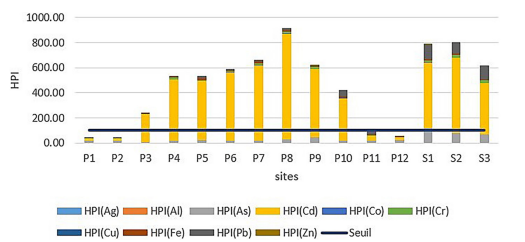
Fig. Variation in heavy metal pollution index (HPI) for all sites statistical analysis
The paper with the title “Heavy Metals Analysis and Quality Evaluation in Drinking Groundwater around an Abandoned Mine Area of Ouichane (Nador’s Province, Morocco)” presents the results of the study concerning the pollution of the Ouichane drinking groundwater by heavy metals in the region, which is associated with the iron mining since 1914 till 1990. The paper first aimed at establishing the extent to which the local populace depends on well and spring water with a view of carrying out a questionnaire survey in assumption that, results indicates that majority of households 44. 90% are not connected to the drinking water network and are dependent on well water. By 88% this water quality is regarded as good The quantitative results of the samples analyzed revealed the following picture of water quality; 1% of the respondents. Nevertheless, ICP-AES of twelve wells and three springs’ samples reveals certain heavy-metal ions including Al, Ag, Fe, Cd, As, Cr, Co, Zn, Pb, Cu, and are found in concentrations higher than the WHO standards. Especially, the total iron content was observed to be significantly high in all the samples. The authors of the study estimate the Heavy Metal Pollution Index (HPI) and determine that 8 out of 12 wells and all 3 springs with HPI greater than the critical level have non-potable water with a high level of contamination. Hence, the study reveals environmental and health effects that may be caused by continuous consumption of contaminated groundwater occasioned by the drought situation in the region. The study thus emphasizes on the importance of the rehabilitation measures and proper use of the sustainable water resources management strategies in order to combat the long-term effects of the mining on the quality of the water in the Ouichane region.
4) Trace Analysis of Heavy Metals in Ground Waters of Vijayawada Industrial Area By Ravisankar Tadiboyina, and Prasada Rao Ptsrk
The paper entitled “Trace Analysis of Heavy Metals in Ground Waters of Vijayawada Industrial Area” authored by Ravisankar Tadiboyina and Prasada Rao Ptsrkb presents a thorough investigation on the factor of heavy metals on the ground water of Vijayawada Industrial situated in Andhra Pradesh, India. The concern to prevent industrial pollution and its effect on water quality is the rationale of the study because of many industries in the city. The researchers also took 60 groundwater samples from different industrial areas and tested for heavy metals that include Aluminum, Arsenic, Cadmium, Chromium, Copper, Iron, Lead, Manganese, Mercury, Nickel, Selenium, and Zinc using AAS. The findings reveal that majority of the samples conform to higher levels of one metal more than the other as compared to the WHO and ISI recommended standards and it is alarming to find that the Cadmium, Copper, Iron and Lead indicated notorious presence levels which are hazardous to the vulnerable people of the respective region. The study also describes how these contaminants are sourced and associated with industries in the area for example power industries, chemical industries and electro plating industries. In conclusion, the authors used their findings to call attention for the improvement of legislation and to pay more attention to waste management for the preservation of water supplies. There are methodological and result sections, the presentation of which is clear, so that this paper is a valuable addition to the collection of literature in the field of environmental science, particularly in the case of industrial pollution and its effects on population health. Although, it could use a more extensive presentation of measures that could help reduce the risks and the socio-economic consequences that can be inferred from the results.
5) Analysis of selected heavy metals in water from river Kuywa and adjacent wells in Bungoma central sub country- Kenya By Wasike Peter Wekesa

Fig. Pollution indexes in river and well water
The paper under discussion is entitled “Analysis of Selected Heavy Metals in Water from River Kuywa and Adjacent Wells in Bungoma Central Sub-County, Kenya” written by Wasike Peter Wekesa Also, this paper will demonstrate how the chosen water sources are contaminated by heavy metals and whether these waters used for domestic and agricultural purposes. This study will seek to establish the concentrations of the heavy metals that include lead (Pb), cadmium (Cd), copper (Cu) and manganese ( Mn) in the water from River Kuywa, and available borehole water and compare it with the WHO/KEBS set limits. This paper was able to establish that the field samples of both river and well water contain high concentrations of Pb, Cu and Cd and this qualifies as a major health risk to the people in the given area. It syntheses the occurrence of these hazards sequentially identifying them as being occasioned by industrial wastes, horticulture business, and residential drainage systems. The statistical analysis carried out using FLAME ATOMIC ABSORPTION SPECTROMETRY and t-test, and variance analysis reveal that there may be seasonal fluctuations in metal concentration showing that there are various forms of environmental pollution in the area. The researchers call for early government intervention measures that would reduce water pollution and ensure the safety of users. Even though the research is well coordinated and yields useful information on the occurrence of environmental pollution in Bungoma, it could have been penetrated deeper on possible solutions and social and economic impact on the affected anthers. Altogether, the paper is very helpful in the sphere of the Environmental Science, especially within the framework of the developing countries, where the industrial and agricultural productions result in the critical pollution of the environment.
6) Analysis of the Distribution of Heavy Metals in Well Water By Fatma Suryani Harahap, Nova Irawati Simatupang
The paper under analysis is entitled as “Analysis of the Distribution of Heavy Metals in Well Water” by Fatma Suryani Harahap and Nova Irawati Simatupang that discusses the levels of lead (Pb), mercury (Hg), and copper (Cu) in well water near Batu Bola landfill in Indonesia. The study is also important because water obtained from this source is widely used for drinking and washing purposes in this area hence any pollution is regarded as a major threat to public health. The authors used an explanatory descriptive research design with the levels of heavy metals analyzed by Atomic Absorption Spectrophotometry (AAS). Thus, their conclusions show the present levels of Pb, Hg, and Cu in the well water are still compliant with the permissible limits set by the Indonesian government standards (Performances No. 492 of 2010, and Government Regulation No. 82 of 2001), which mean that, at present, the well water is quite safe for consumption. However, the finding also reveals the danger of open dumping system used by the landfill which if not controlled, may result to future contamination of sources. On this note, the paper holds that there is need for constant vigil in this regard and improvement of waste management to reduce effects on the environment and human health. However, it is noted that the findings of the research can be considered as basic, and it can be further strengthened by the inclusion of the data collected periodically in the future, as well as the examination of other potential contaminants and the socio-economic effects on the inhabitants of the area. In summary, the study is a peculiar contribution to the environmental science and public health in the areas where poor waste disposal increases the risks of water contamination.
7) Monitoring and assessment of heavy metal Contamination in surface water of selected rivers By Mohsin Khan, Talha Omer, Asad Ellahi, Zahid Ur Rahman, Rizwan Niaz & Showkat Ahmad Lone
The paper by Mohsin Khan et al. (2023) entitled as “Monitoring and assessment of heavy metal contamination in surface water of selected rivers” presents a thorough investigation on the contamination of Swat and Panjkora rivers in the north-east of Pakistan with heavy metals. The parameters included temperature, pH, total dissolved solid, and electroconductivity as well as heavy metals such as iron, chromium, nickel, cadmium, lead, and arsenic and the authors used principal component analysis and cluster analysis to assess these. This study established high levels of pollution where the chromium, cadmium, lead, nickel, and iron concentration surpassed the WHO permissible limits in both the rivers. This contamination has multiple causes of anthropogenic origin such as industrial effluent, agricultural drainage, and unsuitable disposal of waste. The approaches employed to analyze all these factors were found to be valuable in establishing the spatial distribution of pollutants and possible sources. This discovery pinpoints the importance of developing apposite methods of assessing and controlling the effects of heavy metal pollution of water bodies and the harm that results from the poisonous metals to human life. This work presents a detailed qualitative analysis of the 53 sampling sites providing policy makers and environmental scientist’s with valuable information on the extent to which heavy metal contamination is threatening the environment and human health whenever water resources management is compromised. The paper discusses the severities in water pollution with major ecological and societal effects and stresses more on constant monitoring and implementing strict environmental measures to protect the quality of the essential water resources.
8) Determination of heavy metals and health risk assessment in drinking Water in Jigjiga City, Ethiopia By Aderaw Anteneh Belew, Abreham Tesfaye Besha, Aychal Arega Belete
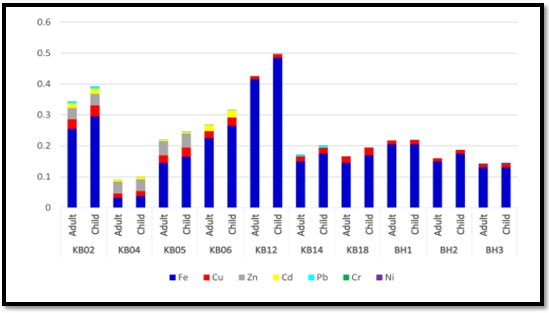
Fig. Total chronic daily intake (CDI) of drinking water samples based on the mean value (CDI= CDIing and CDIder) in mg/kg/day
In the paper, Determination of heavy metals and health risk assessment in drinking water in Jigjiga City, Ethiopia by Aderaw Anteneh Belew, Abreham Tesfaye Besha, and Aychal Arega Belete published in 2024 contains very detail investigation works on heavy metals and their health hazards that exist in Jigjiga City drinking water sources. The seven heavy metals that were detected include Iron (Fe), Zinc(Zn), Copper(Cu), Lead (Pb), Chromium (Cr), Cadmium (Cd) and Nickel(Ni) Nine samples of water from three boreholes and seven taps were analyzed Each sample was determine using flame atomic absorption spectroscopy (FAAS). Should the concentration of these metals be different, then the ratios here revealed ranged from 7. 77±0. 7 to 29. 13±7. 22 mg/L with the iron concentration particularly high. Employing Chronic Daily Intake (CDI), Hazard Quotient (HQ), Hazard Index (HI), and Incremental Lifetime Cancer Risk (ILCR) approaches within a health risk assessment scheme, indicated considerable hazard levels particularly from cadmium, which achieved the highest levels of HQ and defined it as a major carcinogenic agent particularly at the children’s age. This is the reason why the study brings out the extent of the health impacts of heavy metals to the limelight thereby calling for maximum protection. It also focuses more on the consequences of industrial processes, unlawful discharge of wastes and use of fertilizers that pollutes the water underground. To this end, the authors underscore the need for policy coverage for all domains of day-to-day life, along with constant monitoring of the environment in a bid to protect the public health; this research work will be immensely useful to environmental scientists, public health experts as well as policy makers. The methodology used in the paper, literally going from A to Z, as well as logical and accurate data representation to show the need to address the problem regarding the quality of water in Jigjiga City is urgent; it is a global concern.
9) Heavy metals contamination in water, sediments and fish of freshwater Ecosystems in Pakistan By Muhammad Afzaal, Saman Hameed, Iram Liaqat, Amir Amanat Ali Khan, Hafiz abdul Manan, Raja Shahid and Muhammad Altaf
The paper titled ‘Heavy metals contamination in water, sediments, and fish of freshwater ecosystems in Pakistan’ by Muhammad Afzaal, W. Mahmood khan, S. Amjad, T. J. Arif, M. K. Naz, and A. Hussain is an informative and relevant study on the presence of heavy metal in the water bodies of Pakistan with reference to Ravi, Chenab, Kabul and Indus rivers, This work erupted through methodical evaluation of the density of heavy metals including zinc, cadmium, mercury, lead and copper in water, sediment and fish species, and clearly established the bioaccumulation of the heavy metals in the viscera of fish species which have potential dangers on aquatic life and human health. The study concludes that the River Ravi shows the high contamination due to the huge amount of industrial and sewage wastes whereas River Indus has the least contamination because of the large amount of water and less activities of industries.
The disturbance in the ecosystem also affects health in humans since fish with high traces of heavy metal causes different health complications. To the same effect, the paper advocates for efforts to manage wastewater to reduce these effects before being released into rivers. Due to the extensive collection and analysis of data presented in the framework of this study, the urgency of the adoption of strict environmental legislation and the implementation of adequate means of combating pollution in order to preserve the environment and the health of people. This paper is invaluable to researchers, policymakers, and environmentalists who are striving for sustainable water management in Pakistan as a result of the authors’ comprehensive analysis of the sources and effects of heavy metal contamination and its relevance to the future of environmental policy.
10) Toxic heavy metal ions Contamination in water And their sustainable reduction By eco?friendly methods: Isotherms, thermodynamics And kinetics study By Veer Singh, Ghufran Ahmed, Sonali Vedika, Pinki Kumar, Sanjay K. Chaturvedi, Sachchidanand Rai, Emanuel Vamanu & Ashish Kumar
The paper “Toxic heavy metal ions contamination in water and their sustainable reduction by eco-friendly methods: isotherms, thermodynamics, and kinetics study” addresses the critical issue of water contamination due to heavy metals, entailing serious health effects such as liver damage, kidney damage, neurodegenerative effects, and cancer. Therefore, it underlines the urgency for developing ecofriendly, cost-effective ways for removing heavy metal ions from wastewater. This is a prospective method for detoxification, in which biosorption uses biomass from plants, algae, agricultural waste, and microbes for adsorption of these toxic metals. The paper discusses various isotherm models on adsorption processes like Langmuir, Freundlich, and Temkin. The thermodynamics and kinetics associated with the biosorption process are dealt with; mainly, the kinetics model used is the pseudo-second-order kinetics model, which offers an in-depth understanding of the mechanisms involved in adsorption. The findings of the study reiterate the efficacy of biosorption as a tool against heavy metal contamination and, at the same time, open up avenues for its being a very effective and long-term remedy for environmental restorations. It is, in a way, an overview of the updated knowledge on heavy metal contamination and biosorption techniques that adds to the current knowledge base of the area under study and holds key practical implications for improving water quality and public health. The overall research is a great leap toward the solution of one of the world’s most ravaging problems: water source heavy metal pollution.
11) Appraisal of heavy metal pollution in the water resources of Western Uttar Pradesh, India and associated risks By V.C. Goyal, Omkar Singh, Rajesh Singh, Kalzang Chhoden, Sandeep K. Malyan
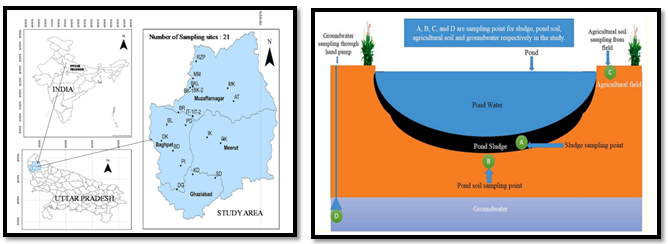
Fig. . Location map of the showing Fig. Sampling site details in the studyponds of the study
The paper “Appraisal of Heavy Metal Pollution in the Water Resources of Western Uttar Pradesh, India and Associated Risks” has been undertaken with one of the most critical issues pertaining to heavy metal contamination of water bodies and their deleterious impact on human health and the environment. The backdrop of the study is the region of western Uttar Pradesh, where storm water and municipal wastewater, often contaminated with hazardous metals, are the major sources of pollution in the ponds. In this way, they are quite important in terms of resources of freshwater; food chains; and ecosystem services, in general. The research in this paper on contamination levels of pond sludge, soils, and groundwater applies different analytical methodologies.
Reporting of the geo-accumulation index and ecological risk index in measuring the concentration of heavy metals indicates very high levels of the metals tested for, which are lead, copper, nickel, zinc, chromium, cadmium, and iron. These further indicated that strict measures of pollution and sustainable practices should be considered in order to reduce the contamination of heavy metals. The authors proposed the eco-friendly biosorption techniques as less expensive and friendly methods in the removal of heavy metals. The present review on the prevailing scenario of heavy metal pollution in Western Uttar Pradesh elaborates not only working domains but also gives practical solutions for reduction, which shall directly contribute towards environmental protection and public health at large.
12) A critical review on chemical analysis of heavy metal complexes in water/wastewater and the mechanism of treatment methods by panelZhe Xu , Qingrui Zhang , Xuchun Li , Xianfeng Huang 2021
The process of eradicating toxic heavy metal complexes (HMCs) from water and wastewaters is extremely crucial for protection of environmental health. However, the application of systems thinking has not cut off all the possibilities of obstacles that need to be overcome. We have several methods to treat water that contains HMC and the various methods may be in use but little is known how these methods works. Why? Well, it is mainly the case that the heavy metals have different characteristics when they are placed in water and it is difficult to observe how they are distributed and coordinated. In this review we now turn our attention to looking at simple techniques of removing HMCs. Brief mention is also made of processes of physical separation and chemical decomplexation. We also stress methods of characterization. They assist to give vital information on the spatial distribution of heavy metals. In addition, we describe some ordinary examples in order to illustrate that the function of changing species is critical to the process of decomplexing HMCs. This helps us come up with other ways of how to approach HMCs as well, we get to rethink on its strategies. Last but not the least we present some of the open problems that we encounter now and what we can expect in future for the research in this field
13) Removal of heavy metal ions from wastewater: a comprehensive and critical review by Naef A. A. Qasem, Ramy H. Mohammed & Dahiru U. Lawal 2021
The detailing of removing heavy metal ions from wastewater can be said to be very crucial for the environment and to our health. There has been used of many mixtures of technologies in trying to treat different types of wastewater. You can group these methods into some categories: Adsorption, membranes, chemical, electrical and photo catalytic processes forms the basis of water treatment. This paper will review all these methods this paper will establish what are agents or adsorbents used, their efficiency, required conditions, and merits or demerits of each one of them. Besides that, it also gives an account of prior research embodied in the literature to aggregate the findings. From a wider perspective, one gets the feeling that many of the new studies are really centered on adsorption processes. Of course, these are not without a few glitches with these methods. Firstly, they are unable to discharge variable sorts of ions at the same time. They also take a long time & the cycling stability of adsorbents is also a problem. Yes of course chemical & membrane methods can do the job, only they have number of problems they generate lots of sludge & they need post treatment procedures which are major concern. Anyway, could fouling & scaling be avoided in the case of membrane separation too the situation could be still more favourable. However, membrane cleaning and pre-treatment increases the cost of the system – oh no! There are also other techniques that can be used; electrical techniques for instance. However, to really crank them up and make them work at a much larger scale, does require some solution to that sludge problem yet again. To the best of the author’s knowledge, there are no studies that specifically compare electric and photocatalytic techniques. To some extent, they are not out of the woods yet. Ideally, more effort should be directed towards the utilization of real wastewater instead of synthetic probes as regards the study of the methods of removing heavy metals. The next studies must focus on identifying and promoting affordable and environmental friendly materials that are sustainable.
14) Removal of Heavy Metals during Primary Treatment of Municipal Wastewater and Possibilities of Enhanced Removal: A Review by Wudneh Ayele Shewa and Martha Dagnew 2020
Recycling resources is therefore a very significant need to uptake once it comes to the treatment of wastewater. At the moment, adding sludge to farms is quite a big deal. Municipal wastewater treatment doesn’t leave out heavy metals as a method of discharge; most of it falls into the effluent or sludge. One may even think that if heavy metals removal in the primary treatment can undergo an enhancement then probably their concentration in both effluent and sludge during secondary treatment can be somehow checked. This could really help us reuse that secondary sludge a very long time.
This review examines where heavy metals surface and how we can eliminate them in the course of primary settling. Also looks at some of the possible treatment tech for removing those metals and how effective they may be.

These fluctuations in total heavy metal concentrations as well as the dissolved portions in ordinary domestic sewage prove that one ought to examine various sites to select the appropriate tech to enhance metal elimination. Unfortunately, while there are many studies that consider heavy metal at a basic dissolved or particulate level there are very few that consider the chemical differences of the elements within these categories. It becomes complicated because sometimes there are incongruencies or we have different knowledge of, for example, hydraulic retention time, pH, and what is in the return flows. This makes it rather difficult to conclusively determine the best practices with regard to pre-treatment of heavy metal removal in primary settlers. But two methods have outperformed all the rest! Interestingly, coagulation/flocculation together with low cost sorbents appear to be the most effective ways to enhance heavy metal removal in primary settling. On the basis of the findings unveiled so far on heavy metals and their removal, it appears that sorption tech may indeed be very effective for Cu and Ni removal. In the same light, coagulation seems to perform well for Cd, Cr, Cu, Pb, Zn & Hg but not so well for Ni.
15) A novel method for the sequential removal and separation of multiple heavy metals from wastewater by Li Fang, Liang Li, Zan Qu, Haomiao Xu, Jianfang Xu, Naiqiang Yan 2017

A new concept in the treatment of wastewater containing heavy metals has been developed. This method uses a special material ZnS nanocrystals (NCs.) This material have proved to have an excellent performance of eliminating toxic metals Hg2+, Cu2+, Pb2+ & Cd2+. Just look at these numbers: it removed 99. Hg2+ and Cu2+ removal efficiencies were to the extent of 9% and 90. Altogether, the content and complexity of the solutions are consistent with the claim that the synthesized compounds are efficacious against 8% of Pb2+, and 66. 3% of Cd2+. That’s pretty impressive! We now find out that the solubility product of these heavy metal sulphides is significant in how well it anchors to the sorbent we have. For instance, Hg2+ was reduced as effectively removed as compared with the case of Cd2+. And guess what? This is because the Ksp for HgS is lower that for CdS In other works, when the Ksp is lower, it appears that those heavy metals bond to the material more eagerly. There’s more good news! In as much as these are sulfides, the variation in the Ksp makes it possible for heavy metals to substitute one another. This gives hope towards the elimination and separation of them one at a time from wastewater. When tested, the heavy metal was precipitated in the order of Ksp values of their respective sulphides. A new method like this one would really come in handy in the cleaning of wastewater, for it is able to extract one heav y metal after the other.
16) Removal of Heavy Metals from Wastewaters: A Challenge from Current Treatment Methods to Nanotechnology Applications by Ruxandra Vidu, ORCID, Ecaterina Matei, Andra Mihaela Predescu, Badriyah Alhalaili , Cristian Pantilimon ORCID, Claudia Tarcea and Cristian Predescu 2020
To get heavy metal out of the water is easier said than done. This requires much attention and checking because these heavy metals can spoil many things. They do not decompose but accumulate in our environment after a certain period of time. Moreover, metallic ions present are toxic particularly those belonging to the heavy metals group; these accumulate within the human system, this creates more pressure to get improved technologies to purify our water. You know, traditional approaches cannot meet increasing demand for cleaner water for drinking or decreasing the amount of debris in wastewater. It grows difficult, even not possible at times, to use modern, advanced technologies for water treatment now a days. That's where nanotechnology shines! It is very nice and it has tone of nifty advantages over other methods. First of all, nanomaterials are cheaper and occupy much less volume. Further, the processes at that small size in terms of time and efficiency are ALL the better. Despite this it is not all rosy as there are some challenges such as, how stable nanomaterials are or if they are toxic – but do not fret! Those are problems which people are striving to solve now. This little review focuses all o n the new things out there for detoxification of heavy metal. It explains the broad strokes of what today’s technologies are, and neatly packages main types of nanoscale materials and how we find those ugly heavy metals.
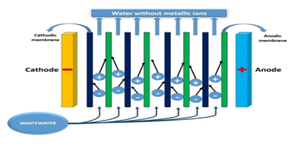
17) Removal of Some Heavy Metals from Industrial Wastewater by Lemmna Mino by Mahmoud Saleh Al-Khafaji, Faris H. Al-Ani & Alaa F. Ibrahim 2018

An aspect of industrial design concerning duck weed and clear flows on the treatment of heavy metals in wastes was undertaken in the experiment with the plant spray drive through designing and building of the plant and the overall operation. Pool duration is 2 hours in case of the first pool and 10 days in case of the second pool. Their experiment looked at the prospect of cadmium, chromium, nickel and lead removal in mixed wastewater by duckweed. The removal efficiencies obtained experimentally have indicated that the average removal of the heavy metals Cd, Cr, Ni and Pb is 44 percent. 93%, 32. 26%, 74. 48% and 79. 1%, respectively. It is established that the cadmium uptake of duckweed plants is relatively low. The plant is a hyperaccumulator of Pb, Cr and Ni. Also the percentage removal of all these heavy metals increased with the concomitant reduction in pH and the percentage increase in acidity ( pH< 7). Consequently, the efficiency of the removal of such metal ions from wastewater considerably depends on its pH. Heavy metals are efficiently adsorbed by duckweed as a phytoremediation species due to the latter’s capability to do so. Treament systems using duckweed is cheap and reliable source of water quality that can conveniently be used for water treatment and other usages.
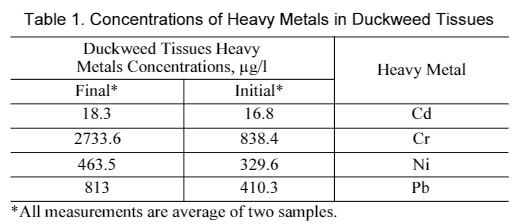
18) Removal and Recovery of Chromium(VI) from Industrial Waste Water by Vinay K. Singh, Prem N. Tiwari
The carbon slurries used in this study were prepared from the waste product of a naphtha based ammonia plant from the Fertilizer Corporation of India, Gorakhpur and the adsorption of Cr(VI) was done in batch mode at different conditions. This removal was favourite at low pH, which was 2. 5 pH. Some effects are also said to have a relation with concentration and temperature. There are two methods of adsorption kinetics: Ball/shear recorded a batch adsorption kinetics that has been described by the Lagergren equation. Validity of the isotherm Langmuir for the present system has been examined at different temperatures. From the adsorption studies of Cr(VI) it was clear that the process was endothermic in the case of carbon slurry system. The utilisation of the adsorbed chromium for a later process has also been demonstrated in this work. Carbon slurry produced as a solid waste in naphtha based ammonia plant of the Fertilizer Corporation of India, Gorakhpur has been employed to study the adsorption of Cr(VI) from aqueous solution at various experimental conditions. The removal was preferred at low pH, and with the optimum pH of 2·5. There are also reports of influence of concentration and temperature.
19) Removal of Heavy Metals from Wastewaters: A Challenge from Current Treatment Methods to Nanotechnology Applications by Ruxandra Vidu, Ecaterina Matei, Andra Mihaela Predescu, Badriyah Alhalaili, Cristian Pantilimon, Claudia Tarcea, and Cristian Predescu1
Water is an essential resource for all living beings, and ensuring its accessibility, affordability, and reliability is a significant challenge. PMIs, or heavy metal ions, are among of the most harmful pollutants. This review highlights recent advancements in chemical and physical methods, especially those involving nanotechnology, for the removal of HMIs such as As, Hg, Cd, Pb, Cr, Ni, Zn, and Cu from water. Electrochemical treatments like electrodialysis, electro filtration, and electrocoagulation are discussed, along with the role of nanomaterials, which offer high surface areas and strong adsorption properties.

Fig. Differential pulse anodic stripping voltammetry (DPASV) curves of bismuth oxycarbide for the simultaneous detection of Cd(II) and Pb(II) (a-top left) [231]; thiacalix [4] arene-modified glassy carbon electrode for the simultaneous determination of tree HMIs (b-top middle) [232]; Hydroxyapatite-Nafion for the simultaneous detection of four HMIs (c-top right) [233]. The calibration curves are presented in (b) and (c) under the respective DPASV curves.
The interactions between HMIs and nanomaterials involve various adsorption mechanisms, making nanotechnology a promising solution for water remediation. Key areas for future research include developing cost-effective and environmentally friendly nanomaterials, enhancing characterization methods to understand adsorption behaviours, evaluating nanomaterials in composites, and customizing electrochemical techniques for complex wastewaters. Advances in this field will not only improve water treatment but also have applications in air remediation and energy due to the shared nanometer-scale mechanisms.
20) Removal of Heavy Metal from Wastewater by Nalenthiran Pugazhenthiran, Sambandam Anandan,and Muthupandian Ashokkumar
Research is looking for new and better ways to remove heavy metals from water. One promising method is using ultrasound technology. When combined with materials that absorb metals, ultrasound can effectively clean polluted water and sludge in an eco-friendly and cost-effective way. The process works because the ultrasound creates tiny bubbles that generate powerful forces and chemicals (like OH radicals) which help remove metals like arsenic. Despite the success in small lab tests, this technology isn't yet used on a large scale. More work is needed to improve and develop special ultrasound equipment for industrial use.
21) New trends in removing heavy metals from industrial wastewater by King Abdulaziz University (KAU)
Over the past 20 years, stricter environmental regulations have demanded better quality of treated wastewater. Many technologies have been developed to remove heavy metals from contaminated water, including chemical precipitation, adsorption, membrane filtration, electrodialysis, and photocatalysis.
A review of 94 articles from 1999 to 2008 shows that:
- Lime precipitation is highly effective for treating wastewater with high metal concentrations (over 1000 mg/L).
- New adsorbents and membrane filtration are widely studied and used for heavy metal removal.
- Photocatalysis is a promising and innovative technique for clean and efficient treatment.
Choosing the best treatment method depends on factors like pH, initial metal concentration, treatment performance, environmental impact, and costs. The key factors in selecting the best system are technical applicability, simplicity, and cost-effectiveness. Considering all these factors is crucial to protect the environment effectively and affordably.

Figure. Processes of a conventional metals precipitation treatment plant (Wang et al., 2004).
22) Heavy Metals Removal from Water and Wastewater by Lavinia Lupa and Laura Cocheci
Each method for removing metal ions from water has its pros and cons, and the choice depends on expertise, water composition, desired efficiency, and operating conditions. Often, multiple methods are combined for optimal results.
- Chemical precipitation is effective for high metal content and has low costs but produces a lot of sludge.
- Coagulation-flocculation shares similar pros and cons with chemical precipitation.
- Ion exchange is good for low metal content but requires significant investment and has issues with resin management.
- Adsorption is cost-effective and easy to operate but has challenges with regenerating adsorbents.
- Membrane separation offers high efficiency but is expensive and prone to fouling.
- Electrochemical processes allow for selective metal recovery but have high energy consumption.
Further studies, especially on real water samples, are needed to develop cost-effective, efficient, and environmentally friendly methods.
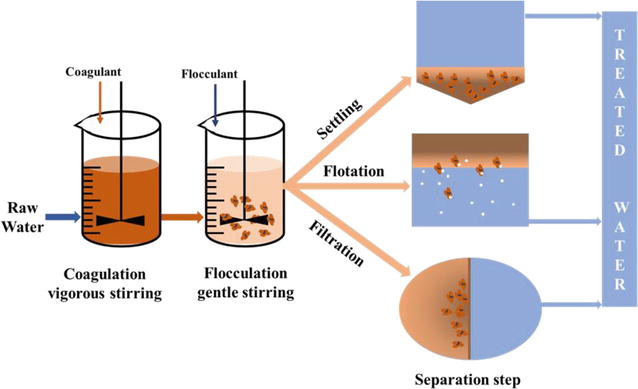
Figure. Scheme of the coagulation-flocculation system.
23) Removal of Heavy Metal from Wastewater: A Review of Current Treatment Processes by S. F. Mohd Noor1, N. Ahmad, M. A. Khattak1, A. Mukhtar, S. Badshah, R. U. Khan
Contamination of heavy metals in wastewater is a major environmental issue worldwide. To comply with stricter environmental regulations, various technologies such as membrane filtration, ion-exchange, and others have been developed for heavy metal removal. Literature shows that ion-exchange and membrane filtration are the most commonly studied methods.
- Ion-exchange is widely used and effective for removing metals from wastewater.
- Membrane filtration can efficiently remove heavy metal ions.
Ion-exchange membrane processes are flexible and capable of addressing diverse issues. Future advancements will come from those who tailor these technologies to specific treatment needs. Selecting the appropriate ion exchange membrane, optimizing operational conditions, and designing the process are crucial for effective treatment.
24) Heavy metal removal from wastewater using various adsorbents: a review by Renu; Madhu Agarwal; K. Singh
This review highlights the effectiveness of commercial and agricultural adsorbents in removing chromium, cadmium, and copper from wastewater. Various adsorbents have been studied, with some showing high adsorption capacities, such as graphene sand composite for chromium (2,859.38 mg/g), chitosan/TiO2 composite for cadmium (256.41 mg/g), and Paenibacillus polymyxa bacteria for copper (1,602 mg/g). The optimum conditions for maximum removal are a pH of 1–2 for chromium, 4–7 for cadmium, and 4.5–6 for copper, with contact times ranging from 120 to 9,900 minutes for chromium, 5 to 120 minutes for cadmium, and 120 minutes to 12 hours for copper. Adsorbent doses vary from 0.75 to 10 g/L for chromium, 0.01 to 4.5 g/L for cadmium, and 0.25 to 1 g/L for copper. The adsorption data fits the Langmuir and Freundlich models, indicating both single and multilayer adsorption behavior. Comparing costs, commercial activated carbon is Rs. 500/kg, whereas bioadsorbents range from Rs. 4.4 to 36.89/kg, making them a cost-effective alternative. Bioadsorbents are also advantageous due to their low cost, availability, no sludge generation, regenerability, technical feasibility, engineering applicability, and high affinity for heavy metal removal.
25) Removal of heavy metal ions from wastewater: a comprehensive and critical review by Naef A. A. Qasem, Ramy H. Mohammed and Dahiru U. Lawal
Choosing the best method for removing heavy metal ions from wastewater depends on cost, metal concentration, environmental impact, and efficiency.
- Adsorption is favoured for its simplicity, high removal rate, and low cost but relies on selecting effective materials and regeneration processes.
- Membrane treatments are effective but face challenges with cost and fouling.
- Chemical treatments like precipitation are cost-effective but produce large volumes of sludge.
- Electric treatments and photocatalysis are less mature but offer eco-friendly benefits with less chemical use and sludge production.
Most studies use synthetic wastewater, so more research with real wastewater and on cost-effective, scalable methods is needed for better heavy metal removal.
26) Removal Methods of Heavy Metals from Laboratory Wastewater by Tamirat Dula Chaemiso, Tariku Nefo
Heavy metal pollution is increasingly problematic due to human activities, making the removal of these metals from wastewater crucial.
Key Removal Methods:
- Physical Methods:
- Adsorption: Uses materials like plant waste to remove metals economically. Pretreatment with alkali or acids can enhance adsorption capacity by increasing active sites or forming new functional groups.
- Biosorption: Involves using biological materials like algae, yeast, and bacteria. Algae primarily use ion exchange, while yeast and bacteria rely on cell wall constituents. This method is eco-friendly and effective for wastewater from electroplating, mining, and chemical industries.
- Chemical Methods:
- Chelation: Effective for removing toxic inorganic compounds that are difficult to treat with biological or physical methods.
Overall, biosorption and adsorption are effective, cost-efficient, and eco-friendly, while chemical methods are best for treating particularly challenging inorganic contaminants.
27) Removal of heavy metals from wastewater using agricultural and industrial wastes as adsorbents by Hala Ahmed Hegazi

Fig1.Heavy metal concentration in El-AHLIA wastewater. Fig.2. Experimental work program for fly ash. Fig3.Experimental work program for rice husk.
The study results indicate:
- Low-Cost Adsorbents: Effective for removing heavy metals at concentrations between 20–60 mg/L.
- Real Wastewater: Rice husk effectively removes Fe, Pb, and Ni, while fly ash is effective for Cd and Cu.
- Removal Efficiency: Depends on the dose and concentration of the adsorbent.
- Contact Time: Maximum adsorption is achieved in two hours.
- Optimum pH: The best range for heavy metal adsorption is 6–7.0.
28) Removal of Heavy Metals from Waste Water by using Various Adsorbents- A Review by Amandeep Kaur and Sangeeta Sharma
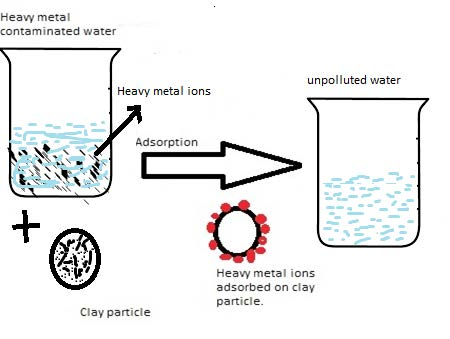
Figure. adsorption phenomena by Clay particle
A comparative study of various adsorbents for removing heavy metals from wastewater found:
- Zinc (Zn): Efficiently removed using Cassava waste with 55.9% adsorption.
- Cadmium (Cd): Best adsorbed by Smectite clay particles, achieving 97% adsorption.
- Lead (Pb): Effectively removed using dried water hyacinth stems and leaves, with a 90% adsorption capacity.
- Copper (Cu): Sugar bagasse was highly efficient, with 94.2% adsorption.
- Nickel (Ni): Also best adsorbed by sugar bagasse, with 87% efficiency.
Conclusion
The findings across multiple studies emphasize the pervasive nature of heavy metal contamination in water sources, particularly in regions with industrial activities and inadequate waste management. The consistent exceedance of permissible levels for metals such as Cadmium, Lead, and Iron highlights an urgent need for effective water treatment solutions and stricter pollution control measures. The health risks associated with prolonged exposure, especially for vulnerable populations like children, underscore the necessity for public health interventions and ongoing monitoring. Moreover, the document calls for rehabilitation efforts in heavily contaminated areas and advocates for eco-friendly remediation technologies like biosorption. Addressing these challenges requires a coordinated effort between local governments, environmental agencies, and communities to ensure safe drinking water and protect ecological systems.
References
[1] https://www.researchgate.net/profile/Mohsen-Nowrouzi/publication/335988235_Analysis_of_heavy_metals_concentration_in_water_and_sediment_in_the_Hara_biosphere_reserve_southern_Iran/links/5ea49ff292851c1a906f2ef0/Analysis-of-heavy-metals-concentration-in-water-and-sediment-in-the-Hara-biosphere-reserve-southern-Iran.pdf [2] https://pdfs.semanticscholar.org/d006/a9d7fbcb5f43174253dede6b553e4cbda7a4.pdf [3] http://www.jeeng.net/Heavy-Metals-Analysis-and-Quality-Evaluation-in-Drinking-Groundwater-around-an-Abandoned,161451,0,2.html [4] https://www.researchgate.net/publication/306172935_Trace_analysis_of_heavy_metals_in_ground_waters_of_Vijayawada_industrial_area [5] https://www.academia.edu/81466599/Analysis_of_Selected_Heavy_Metals_in_Water_from_River_Kuywa_and_Adjacent_Wells_in_Bungoma_Central_Sub_County_Kenya [6] https://www.researchgate.net/publication/352752488_Analysis_of_the_Distribution_of_Heavy_Metals_in_Well_Water [7] https://www.tandfonline.com/doi/epdf/10.1080/10106049.2023.2256313?needAccess=true [8] https://link.springer.com/article/10.1007/s44274-024-00071-z [9] https://iwaponline.com/wpt/article/17/5/1253/88290/Heavy-metals-contamination-in-water-sediments-and [10] https://www.nature.com/articles/s41598-024-58061-3 [11] https://www.sciencedirect.com/science/article/pii/S2666765722000655?ref=cra_js_challenge&fr=RR-1 [12] A critical review on chemical analysis of heavy metal complexes in water/wastewater and the mechanism of treatment methods - ScienceDirect [13] Removal of heavy metal ions from wastewater: a comprehensive and critical review | npj Clean Water (nature.com) [14] Water | Free Full-Text | Removal of Heavy Metals during Primary Treatment of Municipal Wastewater and Possibilities of Enhanced Removal: A Review (mdpi.com) [15] A novel method for the sequential removal and separation of multiple heavy metals from wastewater - ScienceDirect [16] Toxics | Free Full-Text | Removal of Heavy Metals from Wastewaters: A Challenge from Current Treatment Methods to Nanotechnology Applications (mdpi.com) [17] https://link.springer.com/article/10.1007/s12205-017-1112-x [18] https://scijournals.onlinelibrary.wiley.com/doi/abs/10.1002/%28SICI%2910974660%28199707%2969%3A3%3C376%3A%3AAID-JCTB714%3E3.0.CO%3B2-F [19] Removal of Heavy Metals from Wastewaters: A Challenge from Current Treatment Methods to Nanotechnology Applications - PMC (nih.gov) [20] https://www.researchgate.net/publication/304998071_Removal_of_Heavy_Metal_from_Wastewater [21] New trends in removing heavy metals from industrial wastewater - ScienceDirect [22] Heavy Metals Removal from Water and Wastewater | IntechOpen [23] https://www.akademiabaru.com/doc/ARMSV58_N1_P1_9.pdf [24] Heavy metal removal from wastewater using various adsorbents: a review | Journal of Water Reuse and Desalination | IWA Publishing (iwaponline.com) [25] (PDF) Removal of heavy metal ions from wastewater: a comprehensive and critical review (researchgate.net) [26] https://core.ac.uk/download/pdf/234658061.pdf [27] Removal of heavy metals from wastewater using agricultural and industrial wastes as adsorbents - ScienceDirect [28] https://indjst.org/download
Copyright
Copyright © 2024 Deeksha R, Deeksha Singh, Kashish Dokania, Madiha Mujawar . This is an open access article distributed under the Creative Commons Attribution License, which permits unrestricted use, distribution, and reproduction in any medium, provided the original work is properly cited.

Download Paper
Paper Id : IJRASET64077
Publish Date : 2024-08-25
ISSN : 2321-9653
Publisher Name : IJRASET
DOI Link : Click Here
 Submit Paper Online
Submit Paper Online

